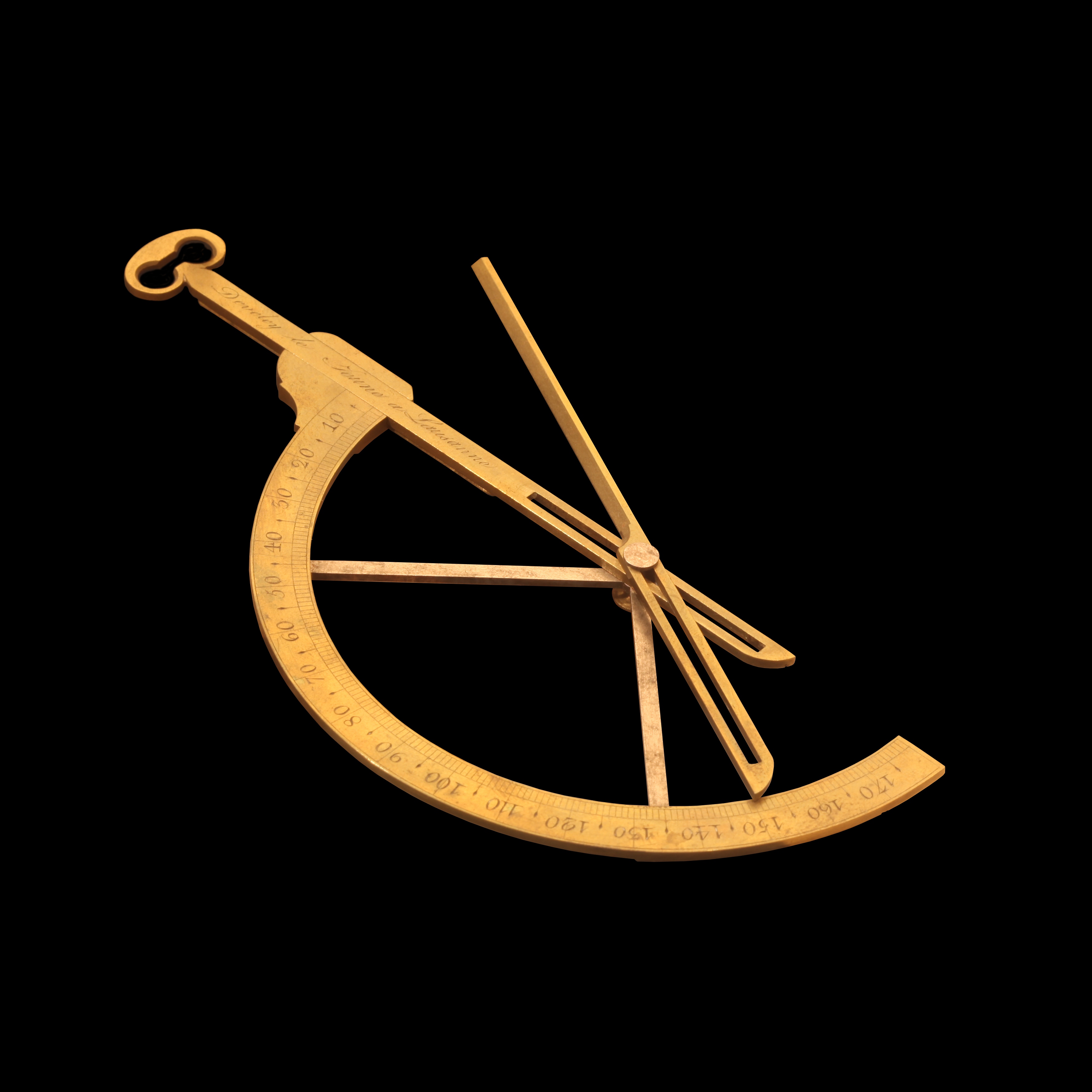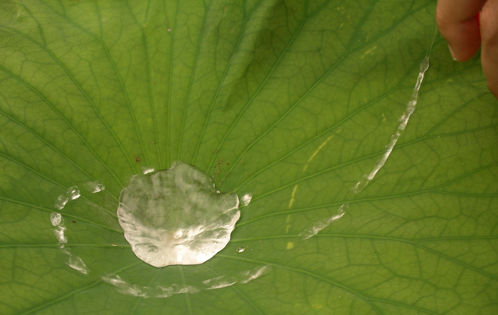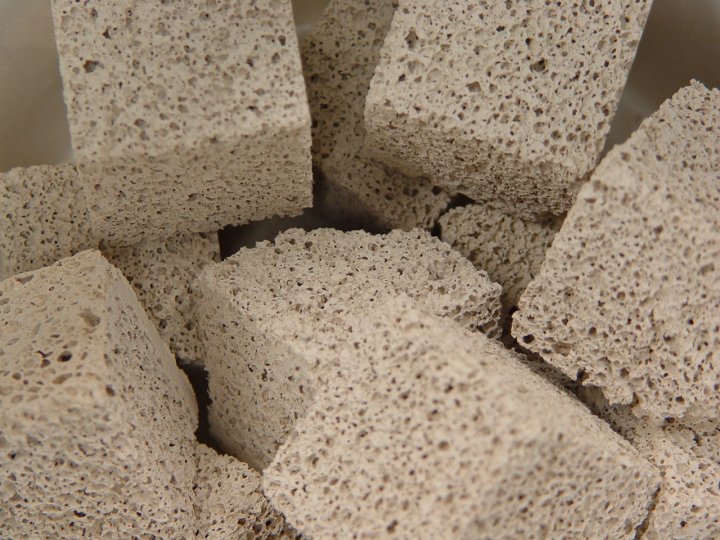|
Cassie's Law
Cassie's law, or the Cassie equation, describes the effective contact angle θc for a liquid on a chemically heterogeneous surface, i.e. the surface of a composite material consisting of different chemistries, that is non uniform throughout. Contact angles are important as they quantify a surface's wettability, the nature of solid-fluid intermolecular interactions. Cassie's law is reserved for when a liquid completely covers both ''smooth'' and ''rough'' heterogeneous surfaces. More of a rule than a law, the formula found in literature for two materials is; \cos \theta_c = \sigma_1 \cos \theta_1 + \sigma_2 \cos \theta_2 where \theta_1and \theta_2 are the contact angles for components 1 with fractional surface area \sigma_1, and 2 with fractional surface area \sigma_2 in the composite material respectively. If there exist more than two materials then the equation is scaled to the general form of; \cos \theta_ =\sum_^N \sigma_k \cos \theta_k , with \sum_^N \sigma_k = 1. Cassie-B ... [...More Info...] [...Related Items...] OR: [Wikipedia] [Google] [Baidu] |
Contact Angle
The contact angle is the angle, conventionally measured through the liquid, where a liquid–vapor interface meets a solid surface. It quantifies the wettability of a solid surface by a liquid via the Young equation. A given system of solid, liquid, and vapor at a given temperature and pressure has a unique equilibrium contact angle. However, in practice a dynamic phenomenon of contact angle hysteresis is often observed, ranging from the advancing (maximal) contact angle to the receding (minimal) contact angle. The equilibrium contact is within those values, and can be calculated from them. The equilibrium contact angle reflects the relative strength of the liquid, solid, and vapour molecular interaction. The contact angle depends upon the medium above the free surface of the liquid, and the nature of the liquid and solid in contact. It is independent of the inclination of solid to the liquid surface. It changes with surface tension and hence with the temperature and purity of t ... [...More Info...] [...Related Items...] OR: [Wikipedia] [Google] [Baidu] |
Surface Roughness
Surface roughness, often shortened to roughness, is a component of surface finish (surface texture). It is quantified by the deviations in the direction of the normal vector of a real surface from its ideal form. If these deviations are large, the surface is rough; if they are small, the surface is smooth. In surface metrology, roughness is typically considered to be the high-frequency, short-wavelength component of a measured surface. However, in practice it is often necessary to know both the amplitude and frequency to ensure that a surface is fit for a purpose. Roughness plays an important role in determining how a real object will interact with its environment. In tribology, rough surfaces usually wear more quickly and have higher friction coefficients than smooth surfaces. Roughness is often a good predictor of the performance of a mechanical component, since irregularities on the surface may form nucleation sites for cracks or corrosion. On the other hand, roughness may pr ... [...More Info...] [...Related Items...] OR: [Wikipedia] [Google] [Baidu] |
Drop (liquid)
A drop or droplet is a small column of liquid, bounded completely or almost completely by free surfaces. A drop may form when liquid accumulates at the lower end of a tube or other surface boundary, producing a hanging drop called a pendant drop. Drops may also be formed by the condensation of a vapor or by atomizer nozzle, atomization of a larger mass of solid. Water vapor will condense into droplets depending on the temperature. The temperature at which droplets form is called the dew point. Surface tension Liquid forms drops because it exhibits surface tension. A simple way to form a drop is to allow liquid to flow slowly from the lower end of a vertical tube of small diameter. The surface tension of the liquid causes the liquid to hang from the tube, forming a pendant. When the drop exceeds a certain size it is no longer stable and detaches itself. The falling liquid is also a drop held together by surface tension. Viscosity and pitch drop experiments Some substa ... [...More Info...] [...Related Items...] OR: [Wikipedia] [Google] [Baidu] |
Goniometer
A goniometer is an instrument that either measures an angle or allows an object to be rotated to a precise angular position. The term goniometry derives from two Greek words, γωνία (''gōnía'') 'angle' and μέτρον (''métron'') 'measure'. The first known description of a goniometer, based on the astrolabe, was by Gemma Frisius in 1538. Applications Surveying Prior to the invention of the theodolite, the goniometer was used in surveying. The application of triangulation to geodesy was described in the second (1533) edition of ''Cosmograficus liber'' by Petri Appiani as a 16-page appendix by Frisius entitled ''Libellus de locorum describendorum ratione''. Communications The Bellini–Tosi direction finder was a type of radio direction finder that was widely used from World War I to World War II. It used the signals from two crossed antennas, or four individual antennas simulating two crossed ones, to re-create the radio signal in a small area between two loops ... [...More Info...] [...Related Items...] OR: [Wikipedia] [Google] [Baidu] |
Contact Angle
The contact angle is the angle, conventionally measured through the liquid, where a liquid–vapor interface meets a solid surface. It quantifies the wettability of a solid surface by a liquid via the Young equation. A given system of solid, liquid, and vapor at a given temperature and pressure has a unique equilibrium contact angle. However, in practice a dynamic phenomenon of contact angle hysteresis is often observed, ranging from the advancing (maximal) contact angle to the receding (minimal) contact angle. The equilibrium contact is within those values, and can be calculated from them. The equilibrium contact angle reflects the relative strength of the liquid, solid, and vapour molecular interaction. The contact angle depends upon the medium above the free surface of the liquid, and the nature of the liquid and solid in contact. It is independent of the inclination of solid to the liquid surface. It changes with surface tension and hence with the temperature and purity of t ... [...More Info...] [...Related Items...] OR: [Wikipedia] [Google] [Baidu] |
Lotus Effect
The lotus effect refers to self-cleaning properties that are a result of ultrahydrophobicity as exhibited by the leaves of ''Nelumbo'', the lotus flower. Dirt particles are picked up by water droplets due to the micro- and nanoscopic architecture on the surface, which minimizes the droplet's adhesion to that surface. Ultrahydrophobicity and self-cleaning properties are also found in other plants, such as ''Tropaeolum'' (nasturtium), ''Opuntia'' (prickly pear), ''Alchemilla'', cane, and also on the wings of certain insects. The phenomenon of ultrahydrophobicity was first studied by Dettre and Johnson in 1964 using rough hydrophobic surfaces. Their work developed a theoretical model based on experiments with glass beads coated with paraffin or Polytetrafluoroethylene, PTFE fluorotelomer, telomer. The self-cleaning property of ultrahydrophobic micro-nanotechnology, nanostructured surfaces was studied by Wilhelm Barthlott and Ehler in 1977, who described such self-cleaning and ultr ... [...More Info...] [...Related Items...] OR: [Wikipedia] [Google] [Baidu] |
Ultrahydrophobicity
Ultrahydrophobic (or superhydrophobic) surfaces are highly hydrophobic, i.e., extremely difficult to wet. The contact angles of a water droplet on an ultrahydrophobic material exceed 150°. This is also referred to as the lotus effect, after the superhydrophobic leaves of the lotus plant. A droplet striking these kinds of surfaces can fully rebound like an elastic ball. Interactions of bouncing drops can be further reduced using special superhydrophobic surfaces that promote symmetry breaking, pancake bouncing or waterbowl bouncing. Theory In 1805, Thomas Young defined the contact angle ''θ'' by analysing the forces acting on a fluid droplet resting on a smooth solid surface surrounded by a gas. :\gamma_\ =\gamma_+\gamma_\cos where :\gamma_\ = Interfacial tension between the solid and gas :\gamma_\ = Interfacial tension between the solid and liquid :\gamma_\ = Interfacial tension between the liquid and gas ''θ'' can be measured using a contact angle goniometer. Wenzel ... [...More Info...] [...Related Items...] OR: [Wikipedia] [Google] [Baidu] |
Cassie Bubble Picture
Cassie is a feminine given name and a short form of various other given names mostly used in English-speaking countries. It is more rarely a surname. People and fictional characters named Cassie include: People with the name Given name or nickname Entertainment * Cassie Davis (born 1986), Australian singer, songwriter and producer * Cassie Gaines (1948–1977), American singer * Cassie Jaye (born 1986), American actress and film director * Cassie Powney (born 1983), British actor * Cassie Ramone (born 1986), American rock guitarist and singer * Cassie Scerbo (born 1990), American actress, singer and dancer * Cassie Steele (born 1989), Canadian actress and singer-songwriter * Cassie Taylor (born 1986), American singer-songwriter and blues musician * Cassie Ventura (born 1986), known mononymously as Cassie, American recording artist, model, actress and dancer * Cassie Yates (born 1951), American actress Sports * Cassie Andrews (cricketer) (1908-1962), Australian cricketer * Cassie ... [...More Info...] [...Related Items...] OR: [Wikipedia] [Google] [Baidu] |
Contact Angle Microstates
Contact may refer to: Interaction Physical interaction * Contact (geology), a common geological feature * Contact lens or contact, a lens placed on the eye * Contact sport, a sport in which players make contact with other players or objects * Contact juggling * Contact mechanics, the study of solid objects that deform when touching each other * Contact process (mathematics), a model of an interacting particle system * Electrical contacts * ''Sparśa'', a concept in Buddhism that in Sanskrit/Indian language is translated as "contact", "touching", "sensation", "sense impression", etc. Social interaction * Contact (amateur radio) * Contact (law), a concept related to visitation rights * Contact (social), a person who can offer help in achieving goals * Contact Conference, an annual scientific conference * Extraterrestrial contact, see Search for extraterrestrial intelligence * First contact (anthropology), an initial meeting of two cultures * Language contact, the interaction of t ... [...More Info...] [...Related Items...] OR: [Wikipedia] [Google] [Baidu] |
Theta
Theta (, ; uppercase: Θ or ; lowercase: θ or ; grc, ''thē̂ta'' ; Modern: ''thī́ta'' ) is the eighth letter of the Greek alphabet, derived from the Phoenician letter Teth . In the system of Greek numerals, it has a value of 9. Greek In Ancient Greek, θ represented the aspirated voiceless dental plosive , but in Modern Greek it represents the voiceless dental fricative . Forms In its archaic form, θ was written as a cross within a circle (as in the Etruscan or ), and later, as a line or point in circle ( or ). The cursive form was retained by Unicode as , separate from . (There is also ). For the purpose of writing Greek text, the two can be font variants of a single character, but are also used as distinct symbols in technical and mathematical contexts. Extensive lists of examples follow below at Mathematics and Science. is also common in biblical and theological usage e.g. instead of πρόθεσις (means placing in public or laying out a corpse). ... [...More Info...] [...Related Items...] OR: [Wikipedia] [Google] [Baidu] |
Thomas Young (scientist)
Thomas Young FRS (13 June 177310 May 1829) was a British polymath who made notable contributions to the fields of vision, light, solid mechanics, energy, physiology, language, musical harmony, and Egyptology. He was instrumental in the decipherment of Egyptian hieroglyphs, specifically the Rosetta Stone. Young has been described as "The Last Man Who Knew Everything". His work influenced that of William Herschel, Hermann von Helmholtz, James Clerk Maxwell, and Albert Einstein. Young is credited with establishing the wave theory of light, in contrast to the particle theory of Isaac Newton. Young's work was subsequently supported by the work of Augustin-Jean Fresnel. Personal life Young belonged to a Quaker family of Milverton, Somerset, where he was born in 1773, the eldest of ten children. At the age of fourteen Young had learned Greek and Latin. Young began to study medicine in London at St Bartholomew's Hospital in 1792, moved to the University of Edinburgh Medical School i ... [...More Info...] [...Related Items...] OR: [Wikipedia] [Google] [Baidu] |
Porous Medium
A porous medium or a porous material is a material containing pores (voids). The skeletal portion of the material is often called the "matrix" or "frame". The pores are typically filled with a fluid (liquid or gas). The skeletal material is usually a solid, but structures like foams are often also usefully analyzed using concept of porous media. A porous medium is most often characterised by its porosity. Other properties of the medium (e.g. permeability, tensile strength, electrical conductivity, tortuosity) can sometimes be derived from the respective properties of its constituents (solid matrix and fluid) and the media porosity and pores structure, but such a derivation is usually complex. Even the concept of porosity is only straightforward for a poroelastic medium. Often both the solid matrix and the pore network (also known as the pore space) are continuous, so as to form two interpenetrating continua such as in a sponge. However, there is also a concept of closed porosit ... [...More Info...] [...Related Items...] OR: [Wikipedia] [Google] [Baidu] |








